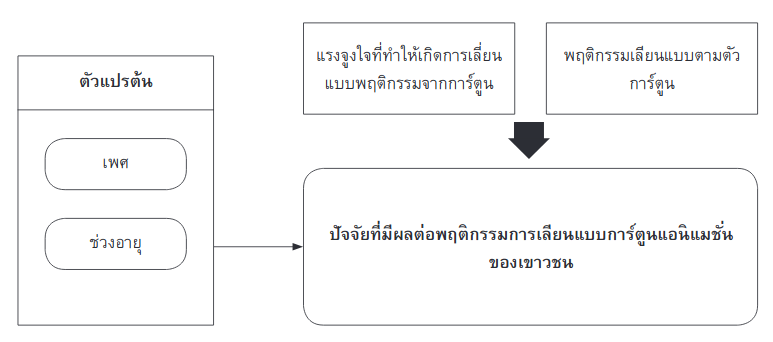Exposure Behaviors and Factors Affecting Animation Cartoon of Youth
Main Article Content
Abstract
Animated cartoon is so significantly impactful to children and youth that it easily creates imitation behaviors among its audience. This research aims to 1) study the acceptance and imitation behaviors among youth 2) analyze the elements that form the factors influencing youth’s imitation behavior 3) compare the differences between these factors between various gender and age range. The data was collected from 175 students majoring in Computer Animation and Game at the Faculty of Informatics, Mahasarakham University. The survey used had the confidence level at 95%. The statistics used in this research was frequency, percentage, mean, standard deviation, t-test, F-test, and Varimax rotation.
The results showed that the participants were mostly youth of age under 20 years old. The reported benefits from watching animated cartoon were promoting creativity and relaxing, causing participants to repeatedly watch the same story for 1-3 times. The imitation behavior approximately started at the age of 9, and the numbers of those who still imitate behaviors from the animated cartoon and those who don’t are not significantly different from each other. The analysis showed that the factors affecting the imitation behaviors were 1) the identity design of cartoon characters and 2) the compelling storytelling of the story. Moreover, the difference in gender doesn’t significantly affect these factors.
Article Details

This work is licensed under a Creative Commons Attribution-NonCommercial-NoDerivatives 4.0 International License.
All authors need to complete copyright transfer to Journal of Applied Informatics and Technology prior to publication. For more details click this link: https://ph01.tci-thaijo.org/index.php/jait/copyrightlicense
References
คุณาสิน อัศวพันธุ์นิมิต และคณะ, 2558. การพัฒนาภาพยนตร์แอนิเมชันสองมิติเรื่อง ขบวนการรักษ์โลก. วารสารครุศาสตร์อุตสาหกรรม มหาวิทยาลัยเทคโนโลยีราชมงคลธัญบุรี. 3(58). 87 - 94.
ชนิตว์สรณ์ ตรีวิทยาภูมิ, 2544. โครงการจัดทำข้อมูลองค์ความรู้ งวดที่ 1 : นิยามธุรกิจการตลาด จุฬาลงกรณ์มหาวิทยาลัย.
ชุติพงศ์ พันธุ์สมบัติ และพงษ์พิพัฒน์ สายทอง, 2559. การพัฒนาสื่อการ์ตูนแอนิเมชัน 3 มิติ โดยใช้เทคนิคการนำเสนอแบบเล่านิทานเป็นฐาน เรื่องการบริโภคอาหาร สำหรับเด็กปฐมวัย. อินฟอร์เมชั่น. 23(59). 39 - 48.
พีรพนธ์ ตัณฑ์จยะ และสุคนธ์ทิพย์ คำจันทร์, 2559. การใช้สื่อประสมแอนิเมชันเพื่อเพิ่มจิตสำนึกความตรงต่อเวลา. วารสารวิชาการมหาวิทยาลัยอีสเทิร์นเอเชีย ฉบับวิทยาศาสตร์และเทคโนโลยี 10(59). 188 - 200.
วัยวัฒน์ สายทุ้ม และคณะ, 2556. การพัฒนาการ์ตูนแอนิเมชัน 3 มิติ เรื่อง “รู้รักษ์ พลังงาน”. การประชุมวิชาการครุศาสตร์อุตสาหกรรมระดับชาติ ครั้งที่ 6. 510 - 516.
สิริวรรณ ยะไชยศรี, สานิตย์ กายาผาด และพงษ์พิพัฒน์ สายทอง. 2558. รูปแบบการ์ตูนแอนิเมชั่น 2 มิติ เพื่อการเรียนรู้ด้านการมีวินัยสำหรับเด็กปฐมวัย. วารสารบัณฑิตศึกษา. 12(57). 123 - 130.
อนุชา เสรีสุชาติ, 2548. การบริหารการผลิตภาพยนตร์แอนิเมชั่น รายงานโครงการเฉพาะบุคคลปริญญามหาบัณฑิต,
มหาวิทยาลัยธรรมศาสตร์ คณะวารสารศาสตร์และสื่อสารมวลชน สาขาบริหารสื่อสารมวลชน.
อมีนา ฉายสุวรรณ และชุมพล จันทร์ฉลอง, 2559. การพัฒนาการ์ตูนแอนิเมชัน เรื่องพี่น้องออมเงิน. วารสารวิจัยและพัฒนาวไลยอลงกรณ์ในพระบรมราชูปถัมภ์. 11(59). 193 - 203.
ธนวุฒิ เศขรฤทธิ์, 2554. การศึกษาพฤติกรรมการเลียนแบบศิลปินต้นแบบละครโทรทัศน์ของนักศึกษามหาวิทยาลัย กรุงเทพ การศึกษาเฉพาะบุคคลเป็นส่วนหนึ่งของการศึกษาตามหลักสูตรนิเทศศาสตรมหาบัณฑิต
ปภังกร ปรีดาชัชวาล, ไฉไล ศักดิวรพงศ์ และสากล สถิตวิทยานันท์, 2556. การยอมรับและพฤติกรรมการเลียนแบบทางวัฒนธรรมจากสื่อบันเทิงเกาหลีของวัยรุ่นไทย. วารสารปัญญาภิวัฒน์. 1(56) 17 - 30.
นิพนธ์ คุณารักษ์, 2551. การวิเคราะห์และวิจารณ์ภาพยนตร์แอนิเมชั่น. วารสารศูนย์บริการวิชาการ. 4(51). 42 - 46.
สุวิช ถิระโคตร, ชญา หิรัญเจริญเวช และคณะ, 2560. เจตคติและแรงจูงใจของผู้เรียนในการใช้แอนิเมชันเพื่อการเรียนรู้. วารสารวิชาการนวัตกรรมสื่อสารสังคม. 5(60). 92 - 101.
กาญจนพิชญ์ ศิริภูวณิชย์ และอุบลวรรณ เปรมศรีรัตน์, 2558 การเล่าเรื่องข้ามสื่อในการ์ตูนไทยของเอกสิทธิ์ ไทยรัตน์. วารสารนิเทศศาสตร์และนวัตกรรมนิด้า. 2(58). 89 - 116.
นิชรา เรืองดารกานนท์. (2557). พฤติกรรมเลียนแบบ ส่งผลเสียต่อเด็กหรือไม่? (ออนไลน์). สืบค้นจาก https://med.mahidol.ac.th/ramachannel/home/article/พฤติกรรมเลียนแบบ-ส่งผลเ/
บรรเจิดพร รัตนพันธุ์. (2545). ต้นแบบแห่งการเรียนรู้ (ออนไลน์). สืบค้นจาก https://www.moe.go.th/main2/article/learn_original.htm
เอกสิทธิ์ไทยรัตน์. (2554). MY MANIA 1. กรุงเทพฯ: LET’S Comic.
Norris, Megan; Lecavalier, Luc (2009). "Evaluating the Use of Exploratory Factor Analysis in Developmental Disability Psychological Research". Journal of Autism and Developmental Disorders.






